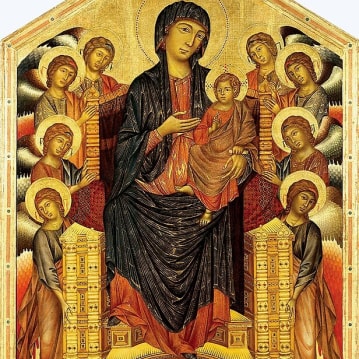Who is Cimabue? Cimabue was born c. 1240-45 in Florence and died in Pisa in 1302. He was a very innovative painter and used linear perspective, reintroduced volume and space, and, most significantly, human emotion in his paintings. While not much is known about his life, Cimabue first appeared in recorded history when it was noted that he witnessed the assumption of patronage by Pope Gregory X (Monastery of Saint Damiano) on June 18, 1272 in Rome. That he was in attendance suggests he was an experienced, well known and respected Florentine artist by that time, particularly as he had traveled from Tuscany to Rome for the event.
Cimabue is also known as Cenni di Pepo or Cenni de Pepi which translates to “bull-head” or “one who crushes the views of others”. A contemporary of his said in 1333 or 1334, “a nobler man than anyone knew, but he was, as a result—so haughty and proud that if someone pointed out any mistake or defect in his work, or if he noted any himself, he would immediately destroy the work no matter how precious it might be.” This information suggests he was a perfectionist and perhaps arrogant along with it.
Works of Cimabue?
Cimabue is also known as Cenni di Pepo or Cenni de Pepi which translates to “bull-head” or “one who crushes the views of others”. A contemporary of his said in 1333 or 1334, “a nobler man than anyone knew, but he was, as a result—so haughty and proud that if someone pointed out any mistake or defect in his work, or if he noted any himself, he would immediately destroy the work no matter how precious it might be.” This information suggests he was a perfectionist and perhaps arrogant along with it.
Works of Cimabue?

